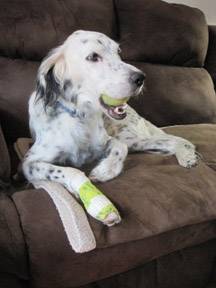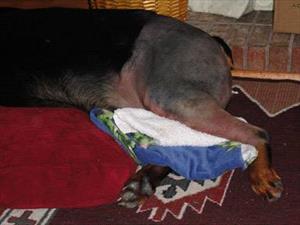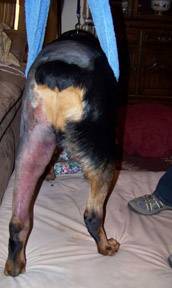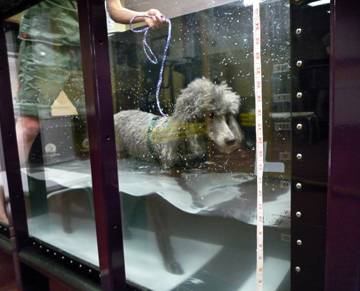
An e-collar should prevent a pet from reaching and disturbing the eye. Photo courtesy of Nanette Walker Smith
After your pet has surgery, post-operative care is critical regarding comfort, safety, and recuperation. Proper post-op care aids healing, minimizes the risk of requiring additional corrective surgeries, speeds recovery, and is vital to a successful outcome. Your pet will be as comfortable as possible, and you will spend less money at the veterinary hospital if you can eliminate the need to go back for preventable problems.
As a general rule, think of how you or another member of your human family would feel after anesthesia and surgery, and what concerns you would have. Although our dogs and cats don’t complain the same way that we do, they are as biologically complex and feel discomfort.
Learn what to expect.
Bruising, Seepage, and Odors
Some bruising may be normal, but excessive bruising might warrant checking with your doctor. Continual seepage of blood or other fluids from the incision is not normal. If there is still intermittent seepage beyond 24 hours post-op, or if the incision has an unpleasant odor (which usually indicates an infection), contact your veterinarian.
Medications
This point cannot be stressed enough: follow the medication schedule exactly and give the prescribed medications for the length of time indicated.
A plastic pill box imprinted with the days of the week can help you avoid missing or doubling a dose.
- Pain medications are necessary in some circumstances. Pain is significantly easier to prevent than to eliminate. Follow your veterinarian’s instructions about pain medications. In the immediate postoperative period, watch for signs that your pet may be uncomfortable. Some people expect an animal to vocalize when in pain, but that’s not always the case. Dogs in pain may be unable to settle down and rest, while cats are more likely to hide and stop eating. Pain-free healing through pharmacology is a good thing.
- If you miss a dose, do not double up on the next dose. Simply resume the dosage schedule with the next treatment and keep giving the medication until it’s gone. Do not use more of any medication than has been prescribed without first checking with your veterinarian.
- Do not give any over-the-counter medications or supplements without discussing them with your veterinarian. Over-the-counter medications such as aspirin, acetaminophen (Tylenol®/paracetamol), and ibuprofen (Advil®/Motrin®) can be toxic or even fatal to pets.
- If your pet is on antibiotics, use all of the medication prescribed, even if your pet appears to feel better. If the antibiotics are discontinued early, the infection may return and may become resistant to the medication.
- Many liquid medications need to be kept refrigerated. Gently shake them or roll them in your hand to remix them before giving them. If a refrigerated medication has been left unrefrigerated, contact your veterinarian’s office to discuss the length of time it was not refrigerated and to find out if you need to replace the bottle.
- If your pet spits out the medicine or doesn’t swallow all of it, don’t give additional medications until the next scheduled dose. This will help avoid overdosing.
- Before you take your pet home after surgery, make sure you understand how to give the medications and what the tools are for dispensing them. Use the specific measuring equipment provided, not your own measuring spoons or syringes. Your veterinary team should give you any necessary tools (a syringe marked with units, pre-filled syringes, etc.). Sometimes syringes are marked as cc (cubic centimeters), but the instructions are written for ml (milliliters). One cc and one ml are the same amount (1 cc = 1 ml), and the terms can be used interchangeably.
- Do not cut or crush tablets unless instructed to do so. Crushed tablets can taste bitter and sometimes make it difficult to determine how much the patient ingested. Some medications can be toxic to humans. Use gloves when handling these medications to protect your health. (Your veterinarian will advise you when this applies.)
- Children should not be allowed to medicate pets.
- Many people will give a pill with a treat, but be aware that some types of treats are inappropriate for certain conditions. For example, giving pills in fatty hot dogs to a pet recuperating from pancreatitis will only make the situation worse.
- Some pets will eat pills along with their food, but many will not. Some options include hiding the pill in sliced turkey or snack-like treats designed to hide a pill. However, ask your veterinary team for tips.
Activity Restriction
Activity is often restricted for a period of time after surgery, ranging from several days to many weeks, depending on the type of surgery. It may be difficult, but it is important.
Restricting a dog’s activity can be challenging, particularly when they begin to feel better, but it is absolutely necessary, even for playful puppies. You may need to keep your dog on a leash at all times, both inside the house and out, including going out for elimination. Be certain you understand what level of activity (including playing, roughhousing, jumping up and down off furniture or counters, getting in and out of vehicles, or running to the doorbell) is or is not acceptable before you bring your pet home.
Inadequately restricting activity is a common cause of postoperative complications and subsequent increased veterinary visits and costs.
Crates are particularly useful during these periods. If you don’t have a crate, consider keeping your pet in a small room such as a half bath or laundry room.
Many pets prefer to be with their people when they aren’t feeling well. Some will try to follow you around the house, up and down stairs, and so on. If you use a crate to restrict activity, move the crate to the room you’re going to be in so your pet doesn’t feel the need to follow you around. The more normal their routine is, the happier they will be.
Some orthopedic surgeries require 2 months or longer for adequate recovery. Back or neck surgeries may require several weeks before an animal is able to walk unaided.
When your veterinarian says it is time for your dog to start limited exercise, such as short walks up and down the driveway or down the block, don’t use a retractable leash. Squirrel-obsessed dogs will bolt no matter how they’re otherwise feeling, and running like that can cause serious complications.
The most difficult part of the healing process is when your pet begins to feel better and wants to be active. Remain firm. Stimulate his mind; feed using food puzzles, give him an interactive toy that doesn’t require him to get up and move. Kong-type toys stuffed with peanut butter can keep dogs active and distracted for several hours (make sure peanut butter is okay with your veterinarian). Sit on the floor to be with your pet. Keep using a crate and restraints throughout the timeframe given to you by your veterinarian.
The key factor to bear in mind is that our pets have no ability to understand and comply with restrictions such as those you would receive from your physician. They cannot abstractly anticipate that certain activity might disrupt their recovery or cause major complications, and they do NOT have any innate sense of how much activity is acceptable. With modern surgical techniques and contemporary strategies for pain control, most dogs and cats will be willing and able to do much more than is in their best interest, well before they should. Therefore, you are obliged to out-think your pet, anticipate all the ways they might enter into inappropriate activity, and establish safeguards to prevent any.
Incisions
To prevent infection, surgical incisions need to remain dry. If the incision becomes dirty, gently clean it with saline solution, such as a contact lens solution. Otherwise, leave it alone. Keep checking the incision frequently until it is completely healed. Check for swelling, oozing, pus, redness, heat, bad odor, loose or missing staples or stitches, or cuts. Excessive licking can irritate an incision and cause infection or drainage. A normal amount of drainage is none to just a few drops.
The incision may be slightly puckered when your pet comes home, but it should continue to improve to normal smooth skin as it heals. If it does not, a recheck with your veterinarian is a good idea.
Incisions generally heal within seven to 14 days. External sutures, staples, etc., should be removed by the veterinary team. Some incisions are closed with buried, absorbable sutures that do not require removal. Your veterinarian will advise you whether there are or are not stitches or staples that require removal, and when.
Do not let your pet lick the incision, as licking can introduce infection or pull the stitches out. The old myth of saliva as being helpful or having antibacterial properties is not true.
Appetite, Elimination, and Bathing
A decreased appetite is usually not a concern for the first day after surgery. If your pet does not eat or drink within 24 hours of going home, though, notify your veterinarian.
Follow your veterinarian's instructions regarding withholding food before surgery. Since food has likely been withheld for some time prior to surgery, many times pets will not have a bowel movement for the first day or two after coming home. This time frame is normally not a concern. If your pet does not produce any stool for two days after returning home, or you have concerns prior to that, call your veterinarian.
Some pets may experience soft stool or mild diarrhea for a day or two after coming home. This can be due to the medications they are taking, the stress from the change in their usual routine, etc. Unless the amount is enough to cause some dehydration in your pet, it is usually not a problem. Call your veterinarian if you are concerned or if it lasts more than one to two days. It is always better to check than to overlook a change in your pet's condition.
Your pet may have some incontinence after surgery. It is not unusual and shouldn’t last long.
If your cat likes to lie down in the litter box, change the litter to shredded newspaper instead of granular litter to avoid getting litter in the incision.
Hold off on giving any baths until after sutures are out and your veterinarian has given permission for bathing.
Cones and E-Collars
Lampshade-like cones, also called Elizabethan collars or e-collars, go around your pet’s neck. These devices, and similar ones, help prevent your pet from irritating the incision, creating an infection, and pulling out stitches or staples. Your veterinarian or a veterinary technician should show you how to put the e-collar on and remove it.
Plastic e-collars can make it hard for your pet to eat or drink. Some e-collars are made of fabric or may be inflatable. These may or may not work depending on where your pet’s incision is located, and there is no point in using one if your pet can still reach the incision. Ask your veterinary team for recommendations.
Eating can be complicated and messy while wearing an e-collar. If so, remove the e-collar so your pet can eat, but do not let them out of your sight while it is off. It only takes a moment for a dog or cat to get at stitches and open an incision, which will be painful, delay healing, and require more veterinary care and cost.
Bandaging, Splinting, and Casting

Bandages must remain dry. Photo courtesy of VIN
After certain surgeries, your pet may need a bandage, splint, or cast. All of these materials need to remain clean and dry. This means staying off damp ground and out of the rain, puddles, mud, the water bowl, kiddie pools, and baths. If it’s raining or the ground is wet when your pet has to go outside, cover the bandage with a plastic bag; check that there are no holes in the bag, and tape it to keep the bag up. Remove the bag and tape as soon as your pet comes back inside. If bandages get wet, have them checked and replaced as needed, as soon as possible.
Problems associated with wet bandages, splints, or casts can run the gamut from an irritated incision to more serious complications.
Bandages need to be checked at least three times a day, and preferably more often than that.
Watch for swelling above or below the material and report any swelling immediately to your veterinarian. If the bandage, splint, or cast is too tight, the swelling will cut off necessary circulation.
Smell the material every day. A new or bad odor indicates that it should be rechecked by the veterinarian as soon as possible, and certainly within a few hours of noticing such a change.

If you use ice for a cold pack, wrap it in a towel to avoid excessive cooling. Photo courtesy of Nanette Walker Smith
-
To reduce swelling, your veterinarian may want you to use a cold pack every 10 to 15 minutes for four to six hours after the surgery. Bags of frozen vegetables are best. If you use ice, place it in a plastic bag and wrap it in a towel to avoid excessive cooling. Check with your veterinarian before using a cold pack.
-
If the leg is splinted, the toes may be left exposed at the bottom, Check the toes each time you check the splint to make sure your pet can still feel their toes (lightly pinch to see if they pull the limb away or otherwise react), and also check toes for excessive swelling or coldness. If you have any concerns with the appearance of the toes or the bandage, immediately call your veterinarian or local veterinary emergency clinic.
-
Your veterinarian may have you apply cornstarch powder to help prevent sores from occurring where the skin is rubbed by the cast or splint. Always check with your veterinarian before applying anything to sores.
-
Splints and casts should be adjusted only by your veterinarian. Some splints need to be used for many weeks.
-
Splints and casts are not always comfortable. Your pet may lick, chew, or mutilate the cast or splint. If you suspect there is a problem, it is better to prevent additional trouble, so talk to your veterinarian sooner rather than later.
Drain Care
Sometimes a drain is placed under an incision, usually because the area was contaminated before surgery. The drain allows any infectious fluids to flow out.
Your veterinarian will provide specific instructions on drain care, but generally, you will need to clean the drain more than once a day and any discharge that seeps out at the base. Your veterinarian will instruct you on when to bring the pet back in to remove the drain.
Slings

A sling can support a dog's hind end when walking. Photo courtesy of Nanette Walker Smith.
Some animals, especially dogs, have a difficult time after surgery in getting up or in the car and need a little help. A long towel can be used as a sling under the hind end to give support. With a leash or harness on your dog, place the towel sling under the belly in a U-shape with the ends up over the back. Grasp the ends and you can lift your pet fairly easily. Toes should touch the ground.
A sling is easily made or can be purchased at a pet supply store. Many styles and brands are available, including unisex and some for males. The clinic staff can demonstrate how to use it. Clean or wash it as needed; males may need it washed more frequently than females.
Tube Feeding
Tube feeding is much less stressful than forcing syringes into the mouth, particularly over a long period of time. If a tube is necessary, it will be inserted surgically. Depending on your pet's needs, it may be placed in the neck (esophagostomy tube or E-tube) or stomach (percutaneous endoscopic gastrostomy tube, or PEG). A jejunostomy tube can be placed inside the PEG tube (PEG-J tube) so that food goes directly to the small intestine rather than through the stomach. A bandage will protect the insertion incision for as long as the tube is in place. Keep the insertion incision clean using an antibiotic ointment as directed.
A PEG tube has to remain in place for at least 10 to 14 days, even if no longer needed, because premature removal of the tube can increase the risk for stomach contents to leak into the abdominal cavity. The PEG-J is particularly useful in cases where gastric content needs to be managed, such as pancreatitis; the J tube can be pulled out, leaving the PEG tube, if appropriate.
Your veterinarian will tell you what type of food to use with the tube. Typically, it is either canned food mixed in a blender with water or liquid recovery food from your veterinarian. In some instances, medication can be given through a tube.
A feeding tube needs some maintenance. Keep it clean by flushing it after feeding to prevent blockage. If it gets blocked, flush it with warm water.
Depending on the type of tube used, it may be left in place for a few weeks or several months.
Some dogs and cats need to wear an e-collar while the tube is in place to prevent the pet from irritating the incision.
Dental Surgery
Leave your pet's mouth alone after dental surgery. You should see some improvement each day. If there is no improvement or your pet seems to be doing worse, inform your veterinarian.
Typically, analgesics (pain medications) are given before and during surgery to reduce post-operative pain. Analgesics will be prescribed by your veterinarian; give them as directed, even if your pet acts like they do not need the pain medication. As mentioned, your pet may not vocalize or show signs you recognize as pain. Preventing pain is significantly easier than relieving it.
Some facial swelling and blood or blood-tinged saliva may be normal for 3 to 5 days. Prevent your pet from pawing or rubbing its face. Pets with sutures, particularly cats, may make funny motions with their tongues. Cats may hide. If you are concerned, contact your veterinarian.
Any rotting smell in the mouth after surgery requires an urgent visit to the veterinarian, as it is most likely caused by the surgery site opening at a suture line (dehiscence). That typically requires another surgery.

The rehabilitation veterinarian gets into the underwater treadmill too when the dog goes in for the first time to help the dog get used to it. Photo by Karen James.
Pets should always have access to fresh water. Pets should be back to chewing fairly normally within 24 to 72 hours. Offer soft food for 14 days. Use the pet’s regular food: dry food soaked in warm water for 15 minutes, or canned, unless the veterinarian prescribes something else. Attitude, daily improvement, and regular urination are important signs to watch as well. Notify your veterinarian if these do not seem normal for your pet.
Abscess Surgery
For lanced and stitched abscesses, your veterinarian may advise using warm compresses for the first few days. A common method is to use a warm, but not hot, wet washcloth applied to the wound for five to 10 minutes several times a day. The washcloth should be as warm as you can stand it against your own skin, and it should be wrung out so that you are applying moist heat, not soaking the wound.
Physical Rehabilitation
Physical rehabilitation is advantageous after certain surgeries. Ask your veterinarian if it is appropriate, and what nearby facilities can guide you on your pet’s physical rehabilitation.
You know your pet best, so if your pet does not seem right post-op or you have any questions, talk to your veterinarian.